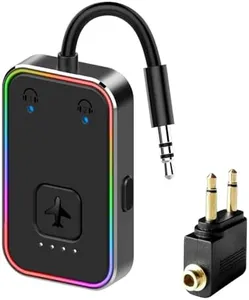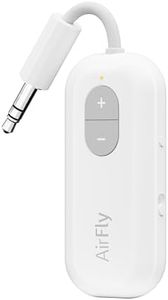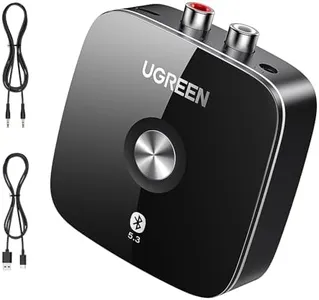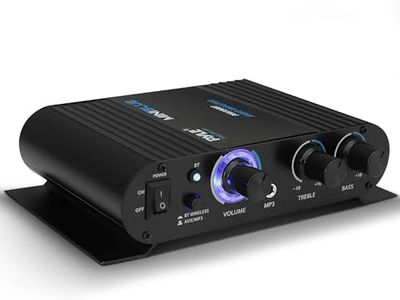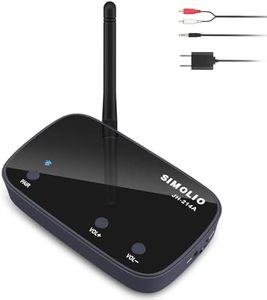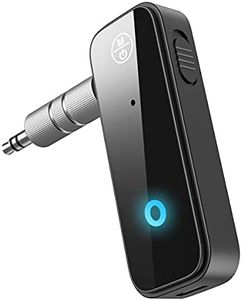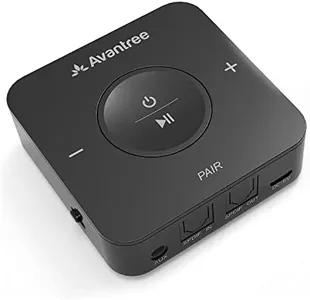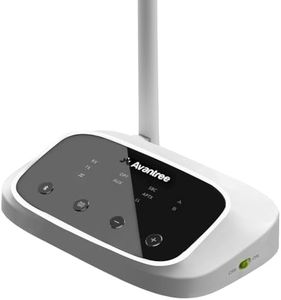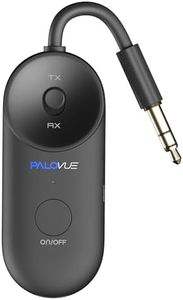10 Best Bluetooth Transmitters 2025 in the United States
Our technology thoroughly searches through the online shopping world, reviewing hundreds of sites. We then process and analyze this information, updating in real-time to bring you the latest top-rated products. This way, you always get the best and most current options available.

Our Top Picks
Winner
Twelve South AirFly SE | Bluetooth Wireless Audio Transmitter Adapter for AirPods/Headphones, 20+ Hr Battery, Works with 3.5mm aux Jacks on Airplanes, TVs, Gym Equipment, and Travel
Most important from
16756 reviews
The Twelve South AirFly SE is a handy Bluetooth transmitter for those looking to use wireless headphones with devices that only have a 3.5mm audio jack, such as airplane entertainment systems or gym equipment. It supports Bluetooth, allowing you to connect it to AirPods or other wireless headphones with ease.
One of its standout features is the impressive battery life, offering over 20 hours of usage on a single charge, which is ideal for long trips. Moreover, it can still function while charging, so you never need to worry about running out of power during use. The device is lightweight and compact, making it easy to carry around. It includes quick pairing mode for effortless connection, enhancing user convenience.
It supports dual pairing, allowing two headphones to connect simultaneously, which is great for sharing audio. The AirFly SE is excellent for travelers and gym-goers looking for wireless freedom and reliable battery life.
Most important from
16756 reviews
Avantree Orbit Pro - Bluetooth Transmitter for TV with LCD Screen & Remote Control, Compatible with Optical or AUX Audio Output & Smart TVs, Easy Volume Control for Airpods & Other Headphones
Most important from
2454 reviews
The Avantree Orbit Pro Bluetooth transmitter appears to be a solid choice for users looking to enhance their TV audio experience with wireless capabilities. One of its standout features is its ability to support dual pairing, allowing you to connect up to two pairs of headphones simultaneously. This is convenient for shared listening. Additionally, it can save up to 8 devices in its history, making reconnections simple and hassle-free. The LCD screen is a nice touch, helping you see which devices are connected at any given time.
The support for aptX Low Latency is another major plus, as it ensures that the audio and visuals remain perfectly synced, which is crucial for a seamless viewing experience. The range is impressive, offering up to 164ft/50m of uninterrupted sound, which is great for larger spaces or if you need to move around while listening. The versatility in connectivity is a significant advantage, with HDMI ARC, optical, 3.5mm AUX, and RCA input ports making it compatible with most TVs and audio devices. This means you can stream high-quality audio from almost any device without issues.
For those who enjoy the richness of surround sound, the Orbit Pro's ability to convert 5.1 to 2.0 for Bluetooth ensures that you can still enjoy your soundbar and headphones without needing to fiddle with TV settings. The Avantree Orbit Pro is particularly suitable for users who want a versatile and high-performing Bluetooth transmitter for their TV, especially those who value low latency, dual pairing, and a wide range of connectivity options.
Most important from
2454 reviews
Avantree Audiplex – Wireless Audio Transmitter & Multiple Receivers Set for AV Receivers, Projectors, PA Systems, Assistive Listening System for Hearing Support, Group Listening in Church Home Theater
Most important from
170 reviews
The Avantree Audiplex is a versatile wireless audio transmitter that stands out for its ability to connect up to 100 devices simultaneously. This makes it ideal for large gatherings, such as in churches, conferences, or PA systems, where multiple listeners need to connect to the same audio source. The transmitter supports connections via AUX or optical jacks, ensuring compatibility with a wide range of devices.
Each receiver also has individual volume controls, allowing users to adjust their own listening levels without affecting others, which is a nice touch for personal comfort in group settings. The 2.4Ghz technology significantly reduces audio lag to 30ms, providing a near lip-sync delay-free experience, which is substantially better compared to standard Bluetooth. The stable range of up to 100 feet (30 meters) ensures reliable performance even in larger spaces.
However, there are a few drawbacks to consider. The system uses 2.4Ghz technology instead of Bluetooth, which might not be compatible with all modern Bluetooth devices. Additionally, while it boasts low latency, it might not be entirely apt for high-fidelity audio enthusiasts who may prefer aptX or other high-quality codecs. The product is battery-powered, which means you'll need to manage and recharge the lithium polymer batteries regularly. Despite these minor issues, the Avantree Audiplex is a solid choice for anyone needing a robust, low-latency, multi-device audio transmitter.
Most important from
170 reviews
Buying Guide for the Best Bluetooth Transmitters
Bluetooth transmitters are devices that allow you to wirelessly send audio from a non-Bluetooth device to a Bluetooth-enabled device, such as headphones or speakers. When choosing a Bluetooth transmitter, it's important to consider several key specifications to ensure you get the best performance and compatibility for your needs. Understanding these specs will help you make an informed decision and find the right product for your specific use case.FAQ
Most Popular Categories Right Now
